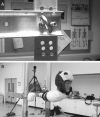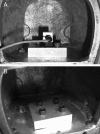Resultant linear acceleration of an instrumented head form does not differ between junior and collegiate taekwondo athletes' kicks
- PMID: 30356507
- PMCID: PMC6188713
- DOI: 10.1016/j.jshs.2015.01.004
Resultant linear acceleration of an instrumented head form does not differ between junior and collegiate taekwondo athletes' kicks
Abstract
Objective: The purpose of this study was to compare the effects of various taekwondo kicks and age (school level) in absolute terms and relative body mass on the resultant linear acceleration (RLA) of an instrumented head form.
Methods: Forty-eight male (middle school: 16; high school: 16; university: 16) taekwondo athletes were recruited for this study. Subjects performed 10 turning, 10 jump spinning hook, and 10 jump back kicks on a Hybrid II head mounted on a height-adjustable frame.
Results: A 2-way (School × Kick) MANOVA was used to determine the differences in RLA between schools (age groups) by type of kick. There was no univariate School main effect for absolute RLA (η 2 = 0.06) and RLA relative to body mass (η 2 = 0.06). No univariate Kick main effects were found for absolute (η 2 = 0.06) and relative RLA (η 2 = 0.06).
Conclusion: It is of concern that RLA did not significantly differ between school levels, implying that young taekwondo athletes generate similar forces to their adult counterparts, possibly exposing young athletes to an increased risk for head injuries.
Keywords: Biomechanics; Concussion; Injury; Martial arts; Taekwondo.
Figures
Similar articles
-
Rotational and linear head accelerations from taekwondo kicks and punches.J Sports Sci. 2018 Jul;36(13):1461-1464. doi: 10.1080/02640414.2017.1398406. Epub 2017 Nov 3. J Sports Sci. 2018. PMID: 29099672
-
Effects of Olympic-style taekwondo kicks on an instrumented head-form and resultant injury measures.Br J Sports Med. 2013 Dec;47(18):1161-5. doi: 10.1136/bjsports-2012-090979. Epub 2012 Aug 28. Br J Sports Med. 2013. PMID: 22930694
-
Biomechanics of head injury in olympic taekwondo and boxing.Biol Sport. 2013 Dec;30(4):263-8. doi: 10.5604/20831862.1077551. Epub 2013 Nov 25. Biol Sport. 2013. PMID: 24744497 Free PMC article.
-
Martial arts injuries.Med Sport Sci. 2005;48:59-73. doi: 10.1159/000084283. Med Sport Sci. 2005. PMID: 16247253 Review.
-
Competition injuries in taekwondo: a literature review and suggestions for prevention and surveillance.Br J Sports Med. 2012 Jun;46(7):485-91. doi: 10.1136/bjsports-2012-091011. Br J Sports Med. 2012. PMID: 22661697 Review.
References
-
- World Taekwondo Federation. WTF approves amendments to para-taekwondo competitions rules, Mauritania as new member to increase global membership to 206. 2014. Taekwondo governing body adds 206th member nation to membership. Available at: http://www.worldtaekwondofederation.net/para-taekwondo/item/1360-wtf-app...; [accessed 14.08.2014].
-
- Kukiwon World Taekwondo Headquarters. 2008. Public membership records. Available at: http://www.kukkiwon.co.kr; [accessed 14.08.2014].
-
- Pieter W., Fife G.P., O'Sullivan D.M. Competition injuries in taekwondo: a literature review and suggestions for prevention and surveillance. Br J Sports Med. 2012;46:485–491. - PubMed
-
- Pieter W. Taekwondo. In: Kordi R, Maffulli N, Wroble RR, Wallace WA, editors. Combat sports medicine. 1st ed. Springer-Verlag; London: 2009. pp. 263–286.
-
- Kirkwood M.W., Yeates K.O., Wilson P.E. Pediatric sport-related concussion: a review of the clinical management of an often neglected population. Pediatrics. 2006;117:1359–1371. - PubMed
LinkOut - more resources
Full Text Sources



